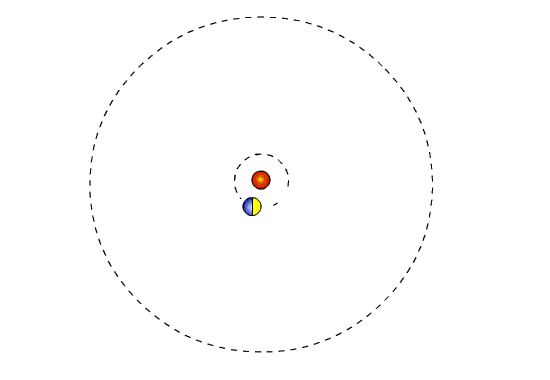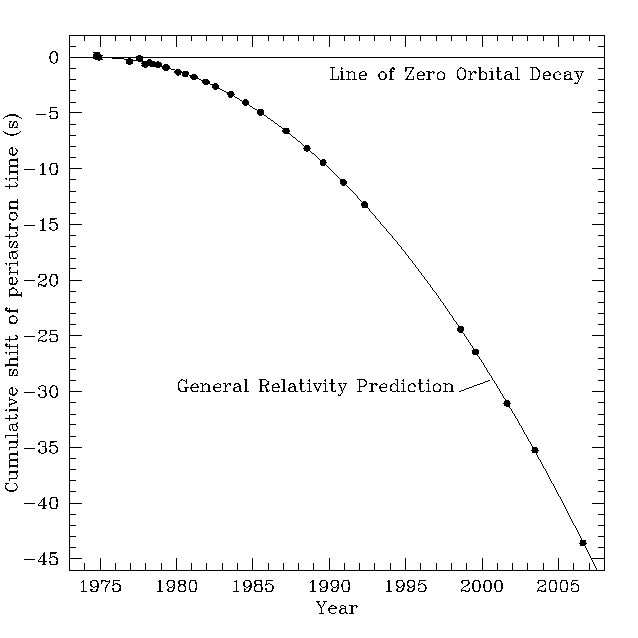

The most exciting measurement in this system is the observation that
the two stars' orbits are shrinking at a rate of 1 cm/day. This
shrinkage is caused by the loss of orbital energy due to gravitational
radiation, which is a travelling ripple in spacetime that is predicted
by Einstein's General Relativity Theory but never previously verified
(see this animation showing
gravity waves from a binary star system as moving undulations in the
spacetime grid). Arecibo observations show that the pulsar orbit
is shrinking at exactly the rate that general relativity predicts it
should, if gravity waves exist and are carrying away the expected
amount of energy.

Figure 1: The evidence that Binary Pulsar B1913+16
emits gravitational radiation. As gravitational radiation carries
energy away from the binary system, the orbit loses energy, the
stars spiral in toward each other, and the pulsar runs "early" in its
orbit. The dots are measurements of how early the pulsar is in
its orbit, while the curve represents the expected behavior if
gravitational waves are carrying energy away from the system at the
rate predicated by Einstein's Theory of General Relativity. The
excellent agreement between observation and theory represents the
strongest current evidence for the existence of gravitational
radiation. (Graph from J.M. Weisberg, D.J. Nice, and J.H. Taylor.)
These observations are the first to show that gravity waves
exist. As a result, astrophysicists currently searching directly
for gravity waves with immense detectors such as LIGO are secure
in the knowledge that their quarry exists. (Fellow department
member Nelson
Christensen and his students are making major contributions to
LIGO.)
Another interesting process first seen in this pulsar is a slow
wobble of its spin axis. The wobble, called "geodetic spin
precession," is caused by the curvature of spacetime induced by the
companion. The wobble enables us to observe different parts of the
pulsar's "lighthouse beam" than would ordinarily be seen. These
measurements will produce a two-dimensional map of the beam until it
precesses away from Earth, probably in a few decades.
These essential tests of general relativity are especially suited to
Arecibo Observatory, with its great sensitivity and advanced
instrumentation. Exciting measurements of this and other binary
pulsars continue to be made with the telescope today.
Sources of further information:
General level, early article
on this pulsar and its use to show that gravitational waves exist:
"Gravitational Waves from an Orbiting Pulsar," J.M. Weisberg,
J.H. Taylor, & L.A. Fowler, Scientific
American, 245, 74 (1981).
Scientific Review Articles on
Binary and (related) Millisecond Pulsars:
"Testing General Relativity with Pulsar Timing," I.H. Stairs, Living Reviews in Relativity , 6, 5
(2003); http://www.livingreviews.org/lrr-2003-5
"Binary and Millisecond Pulsars," D.R. Lorimer, Living Reviews in Relativity , 8, 7
(2005); http://www.livingreviews.org/lrr-2005-7